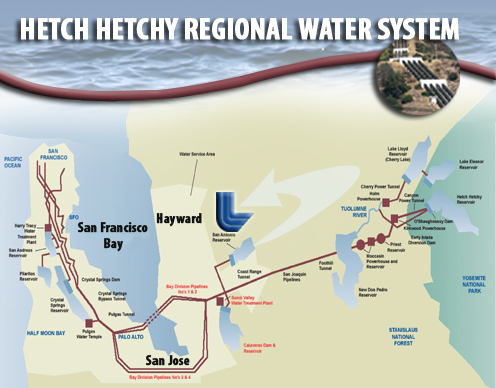From the Pipeline to the Faucet: The Laboratory's Water
Editor’s note: The following article kicks-off a series highlighting water conservation at the Lab, to be published in Newsline and NewsOnline.
During your work day, it’s a quick and easy trip to the faucet. But, it’s not so easy a trip for the water that must flow from a lengthy distance before it arrives for use on site.
The Lab’s water supply originates at San Francisco’s Hetch Hetchy water system. Nine miles south-southeast of the West Gate entrance, three Mocho Station pumps are used to draw water from the Hetch Hetchy Water Coastal Range north tunnel pipeline through an 800-foot deep pump shaft called the Mocho Shaft.
The water is then pumped to the nearby Mocho stand pipe, about 90 feet above and about 370 feet southwest of the Mocho pumps, which in turn feeds to a 6.25 mile-long pipeline.
Storage and usage
Water is stored in three 500,000-gallon epoxy-lined steel tanks at Sandia National Laboratories/Livermore (SNL). The tanks are at an elevated location so that gravity feed supplies water to Sandia and Lawrence Livermore labs with sufficient pressure for fire protection, landscape irrigation, process make-up and domestic water use.
Process water use includes cooling tower make-up, low conductivity water (LCW) production and de-mineralized/de-ionized water production.
Cooling tower water removes the heat from the LCW, which cools the building HVAC and computer rooms’ cooling systems. As the returning hot tower water is cooled, some of it evaporates. Thus, there’s the need for fresh water make-up.
Process water also is used to produce de-ionized water and LCW. De-ionized water is high-purity water used by the Laboratory for various purposes like optics cleaning. Low conductivity water is used for its special properties. It is circulated around the Lab’s network of pipelines. Some of the LCW is lost through pipe joint leaks or is infrequently deliberately bled off from the system while the rest of it is being polished. The lost LCW is made up for with fresh water though the de-ionized water production.
Back-up system
The Hetch Hetchy water system pipeline is constructed and owned by San Francisco and is a part of the Bay Area Water Supply and Conservation Agency (BAWSCA). At times, when Hetch Hetchy water is not available or is insufficient, such as in an emergency or due to maintenance, the LLNL and SNL water supply comes from the Zone 7 Water Agency .
Zone 7 water is pumped through the distribution piping system of LLNL and SNL to the three Sandia storage tanks, using variable speed "jockey" pumps to maintain the prescribed water level for pressure maintenance. (The Zone 7 pump station also includes two fire pumps, one electric- motor-driven and the other a standby diesel driven pump.)
Testing the water
Both Hetch Hetchy and Zone 7 perform water treatment, testing and quality assurance to deliver water that meets or exceeds all state and federal health-related drinking water standards. Additionally, LLNL conducts its own internal testing to ensure that water quality is maintained through to the end user. Water samples are collected regularly from the storage tanks and buildings and the test results are reviewed by an LLNL industrial hygienist.
Find out more about the water system on the Web.








